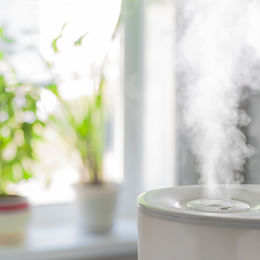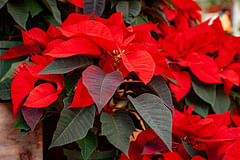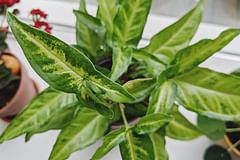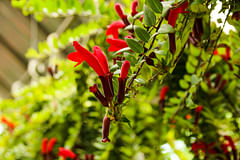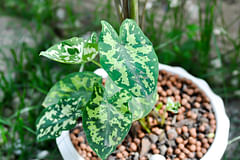How to take care of an Anthurium
The Anthurium is a beautiful plant from the rain forests of South-America and comes in many shapes and sizes. If you love tropical plants, but want something more than just a plant with dark green leaves, the Anthurium is the perfect plant for you! In this plant care guide, we're going to look at how you can help your Anthurium thrive.
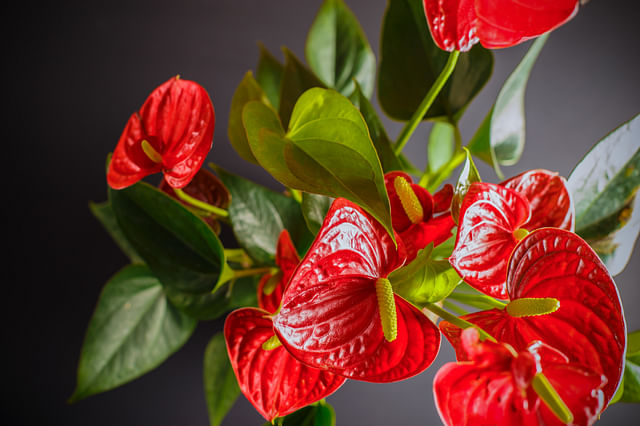
If you love tropical plants but want something that's more than just a plant with dark green leaves, the Anthurium is the perfect plant for you! An Anthurium is a tropical plant with brightly colored or patterned leaves that look a little like Monstera leaves without holes. It's a tropical plant that grows "flowers" in many different colors, including red, pink, purple, white, and orange.
An Anthurium comes in a few different shapes and sizes, ranging from red and white colored leaves to leaves that almost look like Alocasia Polly's leaves. The variety of the Anthurium makes it a great plant family to collect for your house. The many different colors, textures, and shapes will certainly turn your home into an indoor jungle!
In this plant care guide, we're going to explore how to take care of your Anthurium. These are the topics we're going to look at together:
Let's get started and learn to take care of an Anthurium in your house!
How should I choose a healthy Anthurium plant when buying one?
Before we get into the needs of the Anthurium, let's take a quick look into how to choose an Anthurium at the garden center. When you're shopping for an Anthurium plant, it's important to choose a healthy one that will thrive in your home or office.
Here are some tips to help you choose the best plant:
- The leaves of a healthy Anthurium plant should be bright green and glossy. Avoid plants with yellow, brown, or droopy leaves, as these are a sign of stress or disease.
- Lift the plant out of its pot and check out the roots. They should be firm, white, and evenly distributed. If the roots are brown, mushy, or tangled, the plant may be root-bound or suffering from root rot.
- Anthuriums have heart-shaped blooms, which come in a range of colors from red to pink to white. When choosing a plant, look for fully unfolded blooms free of blemishes.
By keeping these things in mind when you're buying your Anthurium, you give yourself the best chance of getting a healthy houseplant that you can help to thrive in your house. Now, let's look at how we can take care of this amazing plant!
Watering your Anthurium
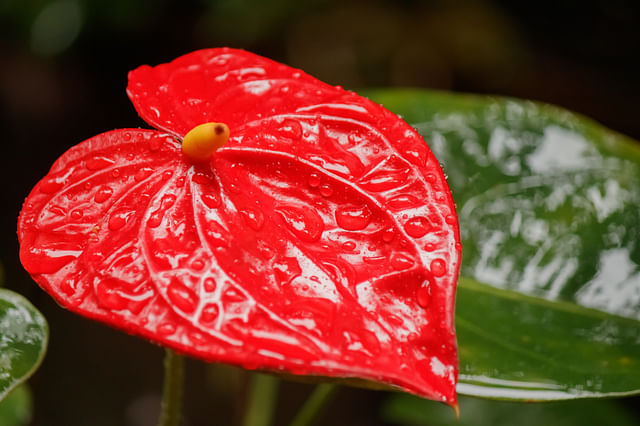
Watering your Anthurium is one of the most important things to make your plant happy. To get an idea of how often you should water your plant, it's good to know where your Anthurium grows in nature: The tropical rainforests of South America. These rainforests are very humid, and warm, and it rains quite often. This gives us a great idea of the type of watering your Anthurium likes: It likes to grow in a permanently moist environment.
What is a "moist" environment?
A moist environment for your plant means 2 things: the soil of your plant should never dry out, but it also shouldn't be in soil that's wet/soggy. You have wet soil if you have a puddle of water at the bottom of the pot or you can see water glistening on the soil.
Most houseplants will die when they're in wet soil because their roots aren't designed to sit in water. If you have wet soil, you risk your plant getting root rot and dying from it.
Moist soil, on the other hand, is damp and won't "shine". Another great way to check if the soil is damp, rather than wet is by taking a small chunk of soil and squeezing it between your fingers. If it drips, it's wet. If it just sticks to your fingers, it's damp and perfect for your Anthurium.
How often should you water your Anthurium?
The Anthurium thrives in soil that's permanently moist, so how often should you water it? Unfortunately, I don't have a fixed number for you, because how often you water your plant depends on the soil. If you've got soil that retains water well and can hold onto water for 5-7 days, you'll only have to water your plant once per week.
The best advice I can give you is to check the moisture levels of your soil every few days until you notice the top layer drying up. You can check whether the soil is still moist by sticking your finger in the top inch of soil. If the soil sticks to your finger, it's still moist and you don't have to water your plant yet. If the soil falls off easily, it's time to water your plant.
When it's time to water your Anthurium, note how long it takes before you have to water your plant again. After a few weeks, you'll start to learn when your plant might need some water to stay happy.
Watering your Anthurium in the winter
In the winter, when your Anthurium goes dormant, you won't have to water your plant as often as you did in the spring and summer. The sun is less strong in the winter, so your plant will (almost) stop growing for a few months. During the winter, you can let the soil of your Anthurium dry out for a few days before you water it again. By letting the soil dry out a little bit, you avoid accidentally overwatering your plant.
How do you know if you've watered too much?
We've all killed houseplants by watering our plants too much. That's why it is important to realize when you've watered your plant too much, so you know to slow down watering for a few days. When the leaves of the Anthurium start to get yellow edges and brown spots, you've watered your plant too much. There is no reason to panic because you can still save your plant! This is what you need to do:
- Let the excess water drain from the pot
- Let the soil (mostly) dry out
- Remove any "dead" leaves to give your plant extra energy to recover
- Water your plant less often
If you want to know more about rescuing your plant from being overwatered, you can read "How to rescue a plant from overwatering".
Sunlight for your Anthurium
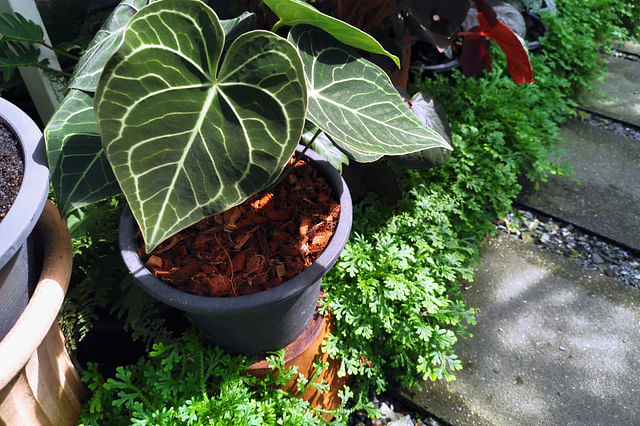
In the previous section, about watering your Anthurium, we've discovered that the plant naturally grows in the rainforests of South America. The Anthurium's natural growing environment is a warm place that gets a lot of sun. It's natural habitat gives us a great idea about how much sunlight your Anthurium should get. In the rainforest, the trees are very large and won't let through most of the bright sunlight to the ground, where the Anthurium grows.
You can help to give your Anthurium the perfect sunlight exposure by finding a bright spot in your house where the plant won't get any direct sunlight exposure. The direct sunlight will turn your Anthurium's leaves yellow and leave sunburn spots.
The perfect place for your Anthurium is a spot in the middle of a room with a south or west-facing window. These rooms will get a lot of sunlight during the day, but by placing your Anthurium away from the window, it won't get any direct sunlight. This spot will keep the brightly colored leaves looking beautiful.
You can read more about the type of sunlight each direction gives you in "Does the sunlight direction matter for your houseplant?".
Sunlight exposure for your Anthurium in the winter
In the winter, the sun isn't as strong and sits lower in the sky during the day. This means that there is less sunlight coming in through the windows and your house is darker during the day.
Because of this, you should move your Anthurium closer to the windows to give it a bit of extra sunlight exposure. During the growing season (spring and summer) this sunlight is too harsh, but it's the perfect sunlight exposure during the winter.
The perfect soil for your Anthurium
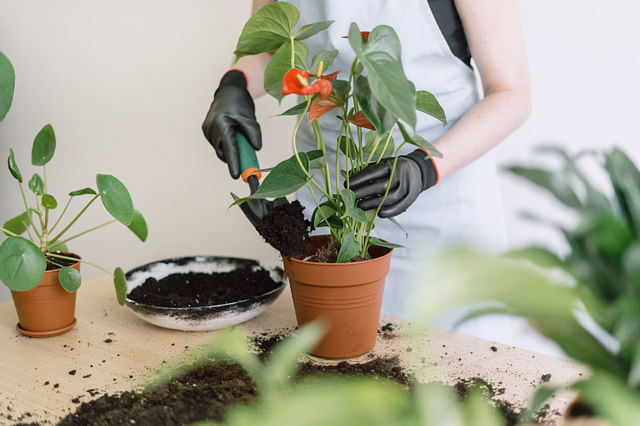
Your Anthurium is a plant that loves permanently moist soil. When you have a plant like that, you'll need soil that has a few important characteristics:
- It drains excess moisture quickly, so you don't overwater your plant
- It keeps its structure for a long time, so the oxygen can still flow to the roots, preventing root rot
- It retains moisture for several days to keep your plant happy
You can find pre-mixed bags of soil at most garden stores, but you can also mix this soil yourself. You will need to mix several ingredients for the best result:
- potting soil
- coconut fibers
- perlite
The potting soil will hold onto fertilizer and moisture to water your plant, the coconut fibers will keep your soil light and fluffy, and the perlite will drain excess moisture to the bottom of the pot quickly. The mix of these ingredients will help your Anthurium to stay happy for a very long time.
Temperature for your Anthurium
Anthuriums, or flamingo flowers, make great houseplants with vibrant flowers and lush foliage. To ensure your Anthurium thrives, it's important to maintain ideal conditions, especially temperature.
What is the ideal temperature range for an Anthurium?
Anthuriums are native to tropical regions, where temperatures typically range from 20 to 30 degrees Celsius (68 to 86 F) during the day and 16 to 21 degrees Celsius (60 to 70 F) at night. This means that they prefer warm, humid conditions, so you'll need to keep them away from cold drafts and protect them against extreme temperature changes.
Anthuriums can handle cooler temperatures briefly, staying below 16 Celsius (60 F) for a longer period may harm leaves and flowers. The same goes for high temperatures: temperatures above 32 Celsius (90 F) can cause wilting leaves/blooms and leaf burn.
To keep your Anthurium happy and healthy, it's important to keep it in a consistent temperature range between 20 to 30 degrees Celsius (68 to 86 F) and make sure that the humidity levels are high. Consider placing your Anthurium in a warm, humid spot in your home, such as a bathroom or near a humidifier. We'll look at more methods for keeping high humidity levels in the next section.
Humidity for your Anthurium
By now, you will have heard that Anthurium is a plant that naturally grows in the rainforests of Brazil, Columbia, Peru, Ecuador, and Venezuela. I keep repeating this because it tells us everything we need to know to keep this amazing plant healthy. Plants that naturally grow in rainforests are plants that thrive in a very high-humidity environment.
What is "humidity"?
Do you know why plants that love humidity don't necessarily like to be watered often? Humidity is all about the moisture in the air around the plant and not about the moisture in the soil. A plant can love humidity, but also be very sensitive to over-watering.
You've probably heard about using a spray bottle on your plants before. It's very easy to assume that spraying your plant is the same as watering your plant because your plant is getting moisture. But this is a common misconception: using a spray bottle on your plant raises the humidity of the air around your plant and doesn't water the plant properly.
How to give your Anthurium the perfect humidity
We've already discovered that you can raise the humidity for your humidity-loving Anthurium by spraying it with water every once in a while. There are a few other ways you can help your Anthurium get the humidity it likes:
- Humidifier
- Cover your plant
- Using a greenhouse
A humidifier is a great way to regulate the humidity levels around your plant but could be a slightly more expensive solution. An easier way to raise humidity is to cover your plant with a glass or plastic dome. This dome will trap the humidity around your plant and mimic the tropical environment of the rainforest it naturally grows in.
If you've got a greenhouse, that's also a perfect place for your Anthurium. It's generally a warm spot with high humidity, just like the tropical rainforests of South America.
There a a few other ways that might be easier for you. You can find these other ways in "10 ways to raise the humidity in your house". This guide will give you 10 different ideas you can try to help give your plant more humidity in your house.
Can I place my Anthurium outside during the summer?
During the warmer summer, it's very tempting to want to bring your houseplants outside. But is this possible for an Anthurium? Yes, but there are a few precautions you should take to make sure your Anthurium stays healthy and happy.
Make sure your Anthurium is not exposed to direct sunlight as it can scorch the leaves. When placing it outside, put your Anthurium under a shady spot or a filtered light area. Also, Anthuriums require a high level of humidity, so it's important to keep the soil moist and mist the leaves frequently to prevent them from drying out.
If you live in an area with extreme temperature fluctuations, it's better to bring your Anthurium indoors during the evening or if the temperature drops suddenly, as they don't tolerate cold weather well.
By keeping the growing conditions as stable as possible for this plant, you can keep it outside during the summer without any problems!
Fertilizing your Anthurium
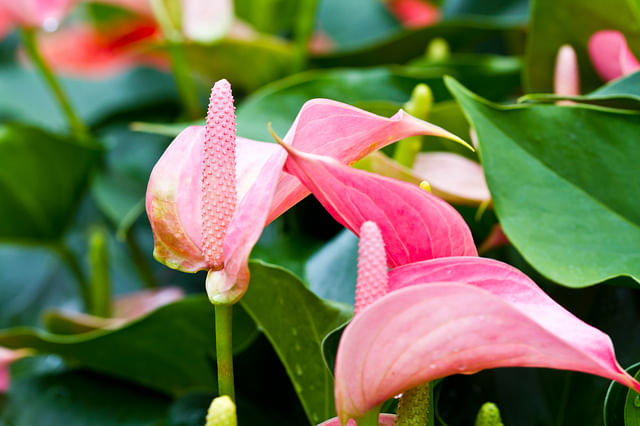
Like most tropical plants, an Anthurium grows quite quickly. When plants grow quickly, they use a lot of the nutrients from the soil, so it's important to keep feeding your plant to keep it happy.
There are a few different types of fertilizer that you can use to feed your Anthurium.
If you're using fertilizer sticks or any other slow-release fertilizer, you only have to feed your plant twice per year. You should fertilize your Anthurium once at the beginning of spring and once at the beginning of the summer. This will give your plant a boost at the beginning of the growing season and give it extra fertilizer to keep growing during the warm summer months.
However, if you're using a liquid fertilizer, you will need to fertilize your plant a little more often. It's important to check the bottle of the fertilizer you've got because every fertilizer is a little different. On average, you should add fertilizer to the water every 14 days and water your plants like you normally would.
You can read more about which fertilizer is best in "What is the best type of fertilizer for houseplants?".
Fertilizing your Anthurium in the winter
In the winter, when your Anthurium is dormant and it's not growing (as quickly), you shouldn't fertilize your houseplant. During this resting period, your Anthurium won't use the fertilizer you're giving it, so it'll stay behind in the soil.
When fertilizer stays behind in the soil for too long, it'll make the soil too acidic for your plant to stay healthy. So it's best to stop fertilizing during the fall and winter.
Pruning an Anthurium
As an Anthurium owner, it's important to learn how to properly prune and care for your plant to make sure it stays healthy and beautiful for long. Luckily, Anthuriums are relatively low-maintenance, but there are a few things you should keep in mind when it comes to pruning.
You should remove any dead, yellowing, or damaged leaves regularly. This can help prevent any potential diseases from spreading and will keep the plant looking fresh. Also, removing any limp blooms can encourage your Anthurium to produce new blooms.
When it comes to pruning your Anthurium, it's important to only remove the dead or dying parts of the plant. Never cut into healthy green leaves or stems, as this can cause damage that may be difficult to recover from.
Repotting your Anthurium
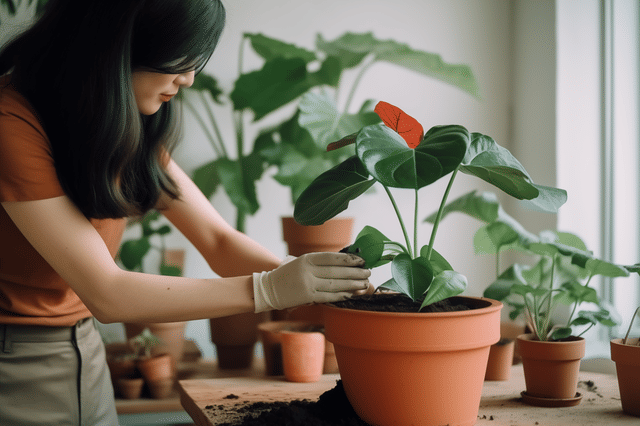
If you've taken excellent care of your Anthurium for a while, you might notice it suddenly stopped growing. Don't worry, it's nothing you've done incorrectly. Your Anthurium might just need to be repotted to spread its roots further and start growing again.
Anthuriums generally prefer to be snug in their pots, however, they do benefit from being repotted every 2-3 years. Repotting doesn't just give your Anthurium more space, but it also gives them some fresh soil.
What type of pot should I use?
When choosing a pot for your Anthurium, make sure to select a container that is only a few inches larger than the plant's current container. If you use a pot that's too large, it can result in waterlogged soil and root rot. Also, make sure that your pot has enough drainage holes to prevent water from collecting in the bottom of the container.
How to repot your Anthurium
To repot your Anthurium, start by gently loosening the soil around the roots and carefully lifting the plant out of its current container. Remove any dead or damaged roots and trim any excessively long roots to encourage healthy growth.
Then, add a layer of fresh potting mix to the new pot, and put your plant in the center of the container, making sure that the top of the root ball is just below the rim of the new pot. This will make watering your plant much easier.
Finally, fill the space around the roots with potting mix and gently press it down to remove air pockets. Water your newly potted Anthurium thoroughly to help the soil settle and place it in bright, indirect sunlight.
Propagating your Anthurium
Propagating an Anthurium plant is quite easy to do. You can multiply your Anthurium plant easily, and it is a great way to share your love for plants with your friends and family.
One easy way to propagate Anthurium is through division. This process involves removing the plant from its current pot, gently separating the roots, and dividing the plant into several sections. Each section should have healthy leaves and roots. These can then be planted in new pots with fresh soil.
Another method is through stem cuttings. Cut off a piece of the stem with a few leaves, making sure that each cutting has one or two nodes. Place the cutting in a jar of water until roots start to form. Once the roots are about an inch long, it's time to transfer the cutting to a new pot.
When you're taking care of Anthurium cuttings, it's important to make sure they are kept in a warm and humid environment with indirect light. Cuttings are very sensitive to environmental changes, so try to put them in a spot with the least temperature and humidity changes throughout the day.
Is your Anthurium toxic for pets?
Most tropical houseplants have at least one thing in common: They're toxic to pets and people. The Anthurium is no exception and will cause stomach aches and/or vomiting. If you notice that your pet or child has eaten part of the Anthurium, make sure to call your veterinarian or GP to ask for advice.
What are the signs that my Anthurium is unhappy or in distress?
Now that you know how to properly take care of this plant, it's time to look at a few signs that your Anthurium might show you when it's not happy. By keeping an eye on these signs, you can catch any problems early on and help your plant recover more quickly.
Here are some of the common signs to look out for:
- If the leaves of your Anthurium start to wilt or turn yellow, it may be a sign of overwatering, poor drainage, or a fungal infection. We'll look closer at this in the next section.
- Brown leaf tips are a sign of dry air or soil. Anthuriums thrive in humid conditions, so make sure to mist the leaves regularly and keep the plant in a humid location.
- If the flowers on your Anthurium start to droop, it may be due to underwatering, overfertilizing, or pests. Check the soil moisture, trim off any dead flowers, and inspect the plant for pests like spider mites or mealybugs. We'll look at pests in the next section.
- If your Anthurium is not growing or producing new leaves, it may be due to a lack of light, poor soil quality, or it being rootbound.
By regularly checking your Anthurium for these signs, you can quickly take action to resolve any issues and keep your plant happy and healthy.
Pests and diseases that can affect an Anthurium

Anthuriums, like all plants, can be attacked by pests and diseases. Common garden pests that can affect these tropical plants include aphids, spider mites, mealybugs, and scale insects. If left unchecked, these pests can cause significant damage to your plants.
Anthuriums are also vulnerable to a few fungal and bacterial diseases, including root rot, leaf spot, and blight. These diseases can lead to yellowing and wilting of leaves, stem and root rot, and even death of the plant if you don't take care of them quickly.
To protect your Anthuriums from pests and diseases, follow these steps: keep the plant clean and dust-free, ensure proper ventilation and lighting, water and fertilize appropriately, and regularly inspect for signs of pests or disease.
A healthy plant is the best protection against problems. Now, let's have a look at how we can deal with pests on an Anthurium.
How to identify and get rid of pests
The first step in treating pests on an Anthurium is to identify the type of pest you're dealing with. Getting rid of each pest is slightly different, so it's important to know which pest is attacking your plant.
- Aphids are small, pear-shaped insects that suck sap from plants, leaving behind a sticky residue.
- Spider mites are tiny, spider-like creatures that feed on plant cells, causing discoloration and webbing.
- Mealybugs are soft, cotton-like insects that latch onto plant stems and leaves, draining the sap and causing yellowing and wilting.
- Scale insects appear as small, immobile bumps on plant stems and leaves and feed by piercing the plant to suck out sap.
The easiest way to get rid of these pests is by using natural remedies that are safe for plants and the environment. For aphids, spray your plants with a solution of water and dish soap, or use neem oil as a natural insecticide. For spider mites, use a mix of garlic (or neem) oil and water and spray your plant with it.
Mealybugs can be removed by rubbing them off with a cotton swab dipped in rubbing alcohol. For scale insects, use a soft brush to gently scrub the bumps off the plant or apply a mixture of water and rubbing alcohol.
How to get rid of diseases
If your anthurium is not suffering from any pests, but instead is suffering from root rot, leaf spot, or blight, there are steps you can take to help your plant get healthy again!
Root rot
First, let's talk about root rot. This condition is caused by overwatering or poor drainage, and it can quickly lead to the death of your plant if you don't fix it quickly. The first step in treating root rot is to carefully remove your Anthurium from its pot and examine the roots. If they're dark, mushy, and/or have a foul odor, it's a sign that root rot is happening.
In this case, you'll need to carefully trim away any affected roots using clean, sharp scissors or pruning shears. Make sure to remove all of the affected tissue, as leaving any behind can allow the infection to spread again. Once you've pruned away the damaged roots, repot your anthurium in fresh, well-draining soil and water it less to make sure the soil stays slightly moist but never gets waterlogged.
Leaf spot
Leaf spot is a fungal infection that can cause brown or black spots to appear on your Anthurium's leaves, and can lead to the leaves wilting and falling off. The first step in treating leaf spot is to remove any affected leaves. Make sure to dispose of them in the trash, not the compost!
From there, treat the remaining leaves with a fungicide spray or liquid, following the instructions on the package carefully. You may also want to increase airflow around your Anthurium by placing a small fan nearby or moving it to a location with better ventilation.
Blight
Blight is a bacterial infection that can cause brown or black spots on the leaves and stem of your Anthurium, and it can quickly spread and cause serious damage. If you think your Anthurium has blight, the first step is to remove any affected leaves and stems using clean, sharp scissors or pruning shears.
You'll want to treat the remaining plant with a bacterial spray or liquid, following the instructions on the package carefully. As with leaf spot, you may also want to increase airflow around your Anthurium to help prevent the infection from spreading.
How do I provide proper ventilation for my Anthurium plant?
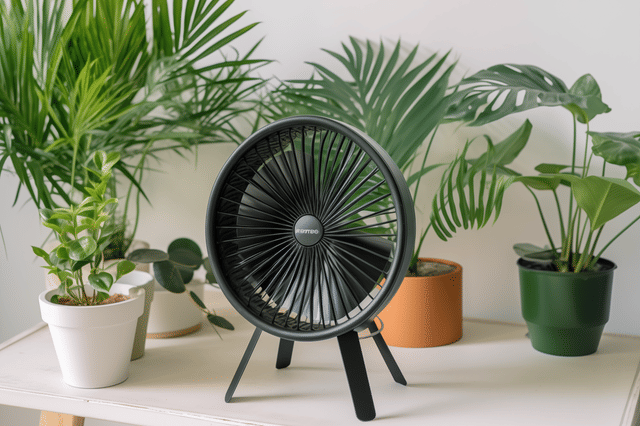
We've discovered that proper ventilation prevents diseases, but how do you give your Anthurium this ventilation?
To provide proper ventilation, place your Anthurium plant in larger open areas where air can flow freely without being blocked by walls or other plants. However, make sure to keep it away from vents that can produce drafts or extreme temperature changes.
If you don't have open spaces left for your Anthurium, you can also consider placing a small fan near your Anthurium to circulate the air around it. This will help prevent stagnant air and promote healthy growth. Keep in mind that a little airflow goes a long way: don't give it so much wind that it damages your plant.
Special care during the growing season
During the growing season in the spring and summer, when your Anthurium grows the most, there are a few things you can do to help your plant stay healthy and get optimal growth.
The most important thing to get right is that your Anthurium is getting the right amount of light and water. These plants require bright, indirect light and moist but well-draining soil to thrive.
To help your plant grow and stay well-fed during the spring and summer, you'll want to use fertilizer. You can use a well-balanced, water-soluble fertilizer once a month.
Another consideration to keep in mind during the blooming season is pest control. Anthurium plants are prone to a few pests, so to keep these pests under control, make sure to keep your Anthurium plant clean and dust-free, and consider using an insecticidal soap or other natural pest control method to prevent infestations.
Conclusion
The Anthurium is a beautiful plant from the rainforests of South America and comes in many shapes and sizes. This humidity-loving, brightly-colored houseplant will make any house into an indoor jungle! In this plant care guide, we've looked at how you can take care of your Anthurium.
We've looked at how you can water your Anthurium, the best sunlight exposure for your Anthurium, the best soil for your Anthurium, how to best fertilize your Anthurium, and whether your Anthurium is safe for your pets and kids.
Thank you for reading this post! I hope it helps you to keep your plants healthy and beautiful! If you're looking for more guides on specific plants, you can always request a plant guide to get a guide for the plant you have trouble with.
Test your plant care knowledge
Quiz completed!
Want to learn more? Sign up for my newsletter to receive free tips in your inbox!
Sign up now!

